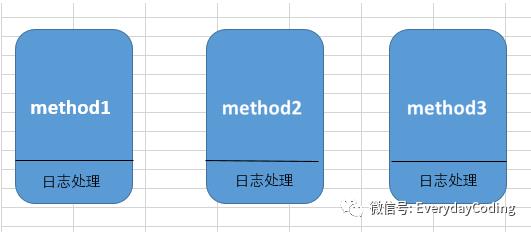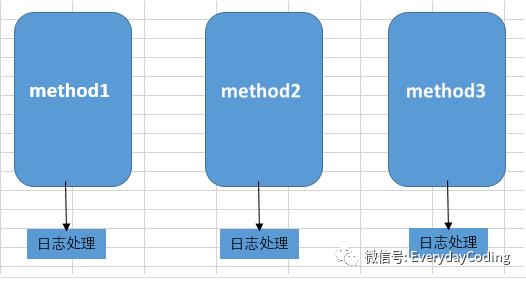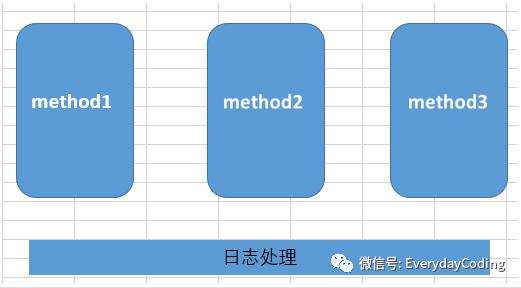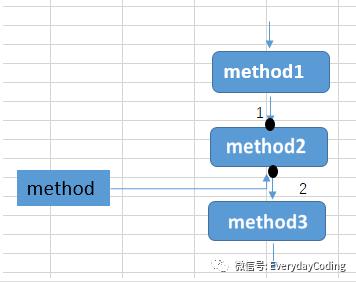Spring还可以这么学--AOP
Posted Java编程社区
tags:
篇首语:本文由小常识网(cha138.com)小编为大家整理,主要介绍了Spring还可以这么学--AOP相关的知识,希望对你有一定的参考价值。
Java,C,C++,python,android,小程序等等资源!
☟ ☟ ☟



java面试题系列
1. 什么是AOP?
AOP(Aspect Oriented Programming),即面向切面编程,可以说是OOP(Object Oriented Programming,面向对象编程)的补充和完善。
2. AOP的作用?
利用一种称为"横切"的技术,剖解开封装的对象内部,并将那些影响了多个类的公共行为封装到一个可重用模块,并将其命名为"Aspect",即切面。所谓"切面",简单说就是那些与业务无关,却为业务模块所共同调用的逻辑或责任封装起来,便于减少系统的重复代码,降低模块之间的耦合度,并有利于未来的可操作性和可维护性。
首先我们来看没有AOP时,如果我们要做日志处理,就得在每个方法中添加

但大多数日志处理代码都是相同的,所以我们将日志处理抽离成一个新的方法,但是尽管这样,我们还得手动插入这些方法。

但这样代码的耦合度很高,当我们要更改这个功能时,就得一个个更改
使用AOP后

为了在指定位置执行这些横向的功能,需要知道指定的是什么地方

例如上图,方法级别的aop实现,在一个程序执行链条中,把method2称为切点,也就是说在method2执行时会执行横切的功能,那么是在method2之前还是之后呢,又是执行什么呢?这些都由advice(通知)来指定。
Spring 方面可以使用下面提到的五种通知工作:

3. AOP的核心概念
横切关注点:对哪些方法进行拦截,拦截后怎么处理,这些关注点称之为横切关注点
切面(aspect):类是对物体特征的抽象,切面就是对横切关注点的抽象
连接点(joinpoint):被拦截到的点,因为Spring只支持方法类型的连接点,所以在Spring中连接点指的就是被拦截到的方法,实际上连接点还可以是字段或者构造器
切入点(pointcut):对连接点进行拦截的定义
通知(advice):所谓通知指的就是指拦截到连接点之后要执行的代码,通知分为前置、后置、异常、最终、环绕通知五类
目标对象:代理的目标对象
织入(weave):将切面应用到目标对象并导致代理对象创建的过程
引入(introduction):在不修改代码的前提下,引入可以在运行期为类动态地添加一些方法或字段
4. AOP实现方式
Spring AOP的XML实现方式
Employee.java文件
package com.wangc;public class Employee { private String name; private int age; public String getName() {
System.out.println("name = "+name); return name;
} public void setName(String name) { this.name = name;
} public int getAge() {
System.out.println("age = "+age); return age;
} public void setAge(int age) { this.age = age;
} public void printThrowException() {
System.out.println("发生异常"); throw new IllegalArgumentException();
}
}Logging.java文件
package com.wangc;public class Logging { //在一个方法执行之前,执行通知。
public void beforeAdvice(){
System.out.println("执行employee的方法之前执行.");
} //在一个方法执行之后,不考虑其结果,执行通知。
public void afterAdvice(){
System.out.println("执行employee的方法之后执行.");
} //在一个方法执行之后,只有在方法成功完成时,才能执行通知。
public void afterReturningAdvice(Object retVal){
System.out.println("返回:" + retVal.toString() );
} //在一个方法执行之后,只有在方法退出抛出异常时,才能执行通知。
public void AfterThrowingAdvice(IllegalArgumentException ex){
System.out.println("抛出了一个异常: " + ex.toString());
}
}Beans.xml文件
<?xml version="1.0" encoding="UTF-8"?><beans xmlns="http://www.springframework.org/schema/beans" xmlns:xsi="http://www.w3.org/2001/XMLSchema-instance" xmlns:aop="http://www.springframework.org/schema/aop" xsi:schemaLocation="http://www.springframework.org/schema/beans http://www.springframework.org/schema/beans/spring-beans-3.0.xsd http://www.springframework.org/schema/aop http://www.springframework.org/schema/aop/spring-aop-3.0.xsd ">
<aop:config>
<!-- 声明一个aspect,logging将被依赖注入 -->
<aop:aspect id="log" ref="logging">
<!-- 声明一个切入点 ,该切入点将与 com.wangc 包下的Logging类的方法相匹配,这里的“*”是通配符-->
<aop:pointcut id="all" expression="execution(* com.wangc.*.*(..))"/>
<!-- 定义一个前置通知 -->
<aop:before pointcut-ref="all" method="beforeAdvice"/>
<!-- 定义一个后置通知 -->
<aop:after pointcut-ref="all" method="afterAdvice"/>
<!-- 定义一个返回后通知 -->
<aop:after-returning pointcut-ref="all" returning="retVal" method="afterReturningAdvice"/>
<!-- 定义一个抛出异常后通知 -->
<aop:after-throwing pointcut-ref="all" throwing="ex" method="AfterThrowingAdvice"/>
</aop:aspect>
</aop:config>
<bean id="employee" class="com.wangc.Employee">
<property name="name" value="zhangsan" />
<property name="age" value="28" />
</bean>
<bean id="logging" class="com.wangc.Logging"/> </beans>MyApp.java文件
package com.wangc;import org.springframework.context.ApplicationContext;import org.springframework.context.support.ClassPathXmlApplicationContext;public class MyApp { public static void main(String[] args) {
ApplicationContext context = new ClassPathXmlApplicationContext("Beans.xml");
Employee employee = (Employee) context.getBean("employee");
employee.getName();
employee.getAge();
employee.printThrowException();
}
}执行结果:
执行employee的方法之前执行.
name = zhangsan
执行employee的方法之后执行.
返回:zhangsan
执行employee的方法之前执行.
age = 28执行employee的方法之后执行.
返回:28执行employee的方法之前执行.
发生异常
执行employee的方法之后执行.
抛出了一个异常: java.lang.IllegalArgumentException
Exception in thread "main" java.lang.IllegalArgumentException
......注意:上面的例子只有一个横切关注点,如果有多个横切关注点,可以使用aspect里的order属性来控制横切关注点的顺序。
......
<aop:config>
<aop:aspect id="log1" ref="logging1" order="1">
<aop:pointcut id="addTime" expression="execution(* com.wangc.*.*(..))"/>
<aop:before pointcut-ref="addTime" method="beforeAdvice"/>
</aop:aspect>
<aop:aspect id="log2" ref="logging2" order="2">
<aop:pointcut id="printLog" expression="execution(* com.wangc.*.*(..))"/>
<aop:before pointcut-ref="printLog" method="beforeAdvice"/>
</aop:aspect>
</aop:config>
......Spring AOP 的 @AspectJ实现方式
这里只需要在上面的基础上修改以下两个文件就可实现,修改后的文件如下:
Beans.xml文件
<?xml version="1.0" encoding="UTF-8"?><beans xmlns="http://www.springframework.org/schema/beans" xmlns:xsi="http://www.w3.org/2001/XMLSchema-instance" xmlns:aop="http://www.springframework.org/schema/aop" xsi:schemaLocation="http://www.springframework.org/schema/beans http://www.springframework.org/schema/beans/spring-beans-3.0.xsd http://www.springframework.org/schema/aop http://www.springframework.org/schema/aop/spring-aop-3.0.xsd ">
<!-- 自动扫描被@Aspect标注的切面 -->
<aop:aspectj-autoproxy />
<bean id="employee" class="com.wangc.Employee">
<property name="name" value="zhangsan" />
<property name="age" value="28" />
</bean>
<bean id="logging" class="com.wangc.Logging"/> </beans>Logging.java文件
package com.wangc;import org.aspectj.lang.annotation.After;import org.aspectj.lang.annotation.AfterReturning;import org.aspectj.lang.annotation.AfterThrowing;import org.aspectj.lang.annotation.Aspect;import org.aspectj.lang.annotation.Before;import org.aspectj.lang.annotation.Pointcut;@Aspectpublic class Logging { @Pointcut("execution(* com.wangc.*.*(..))")
private void all() {
} //在一个方法执行之前,执行通知。
@Before("all()")
public void beforeAdvice(){
System.out.println("执行employee的方法之前执行.");
} //在一个方法执行之后,不考虑其结果,执行通知。
@After("all()")
public void afterAdvice(){
System.out.println("执行employee的方法之后执行.");
} //在一个方法执行之后,只有在方法成功完成时,才能执行通知。
@AfterReturning(pointcut = "all()", returning="retVal")
public void afterReturningAdvice(Object retVal){
System.out.println("返回:" + retVal.toString() );
} //在一个方法执行之后,只有在方法退出抛出异常时,才能执行通知。
@AfterThrowing(pointcut = "all()", throwing="ex")
public void AfterThrowingAdvice(IllegalArgumentException ex){
System.out.println("抛出了一个异常: " + ex.toString());
}
}这里做个简单的说明: 用@Aspect的注解来标识切面,注意不要把它漏了,否则Spring创建代理的时候会找不到它,@Pointcut注解指定了切点,@Before、@After、@AfterReturning和@AfterThrowing指定了运行时的通知。
运行结果:
执行employee的方法之前执行.
name = zhangsan
执行employee的方法之后执行.
返回:zhangsan
执行employee的方法之前执行.
age = 28执行employee的方法之后执行.
返回:28执行employee的方法之前执行.
发生异常
执行employee的方法之后执行.
抛出了一个异常: java.lang.IllegalArgumentException
Exception in thread "main" java.lang.IllegalArgumentException
......分享给更多的小伙伴吧,大家共同学习,共同进步!!!
觉得不错?点个赞吧!!!
QQ学习交流群:713479727
微信学习交流群:微信群【加入方式订阅号下方菜单栏-->学习资源-->微信群】
欢迎大家加入。。。
让梦想从这里启航吧!
以上是关于Spring还可以这么学--AOP的主要内容,如果未能解决你的问题,请参考以下文章